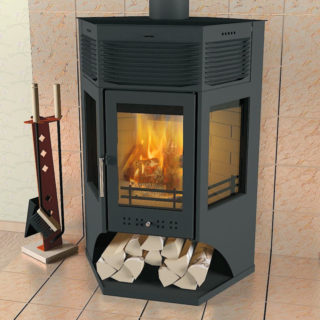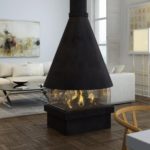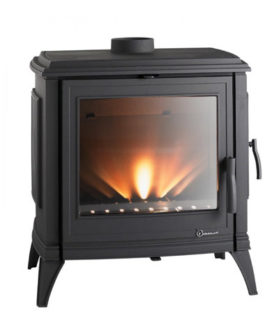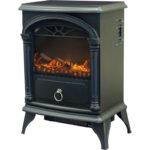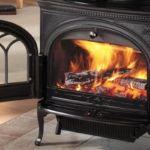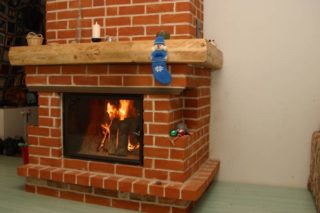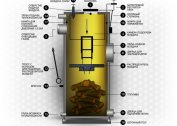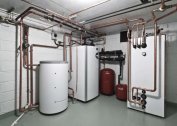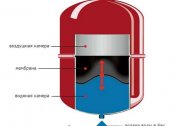A fireplace stove is a new type of equipment for heating and heating. It differs fundamentally from its counterparts in increased work efficiency and complete safety. Such devices allow you to heat the room and delight the eye with a real flame. In fact, these are mini-fireplaces that do not require laborious installation. To drown them, firewood is most often used. Such heating equipment is used in private summer houses and cottages, where people do not live on a permanent basis.
Fireplace stoves depending on the location
Depending on the location, the following models are distinguished:
- Corner This is the most popular and original type of stove for a summer residence. It is located in the corner and looks very attractive with proper installation. The corner fireplace takes up little space in the room and complements the interior if the opening of the stove is oriented along the axis of the angle formed by the walls. Previously, inclined walls of the smoke chamber were used in these types, but over time, the two-chamber version became popular. Outdoor space is needed more for decorations and other solutions. The chimney is mounted in one of the walls of the room. The outer part of the chimney is made of metal, concrete and other blocks. Finishing is done by brick, plaster or special stone.
- Island. A fireplace that stands alone. It is made in the form of a flat platform slightly above floor level. Island fireplaces are divided into open and closed. The smoke and steam collector is always located above this site and connected to the chimney. This option is quite original with proper design, but has low heat dissipation and takes up a lot of space.
- Wall. Fireplaces that are located against the wall. One of the most sought after types. The chimneys of these stoves are mounted in a wall that is protected from fire and heat. This view has a huge number of options for decoration and decoration. Everything tastes the owner.
- Embedded. They save space as much as possible, but for installation you will have to prepare a niche or disassemble the wall. Installation is carried out directly during the construction of the house. To create such an option in an already built house is a difficult and expensive task.
- Island model
- Embedded model
- Corner model
It is necessary to decide what type of furnace to install immediately before creating its scheme or when purchasing equipment. It all depends on the footage of the premises and the purpose of the fireplace itself.
Heaters depending on the heating method
Not all heating structures operate on the same fuel. An ordinary original fireplace drowns a tree, and new types use natural gas or other combustible substances with high heat dissipation. Depending on the heating method, the fireplace stoves are divided into several types.
- Gas. They are gaining more and more popularity in the CIS. In Europe, they have long become a part of almost any autonomous heating system of a private house. They differ from other types in the following advantages: meeting modern requirements for heating systems, clean gas combustion, the ability to conveniently control combustion. In terms of efficiency, this type of equipment is in no way inferior to firewood with an efficiency of 75%. It will ultimately come out a little more expensive, but you will have to tinker with the firewood additionally: to prepare, transport them.
- Wood burning. Classic fireplaces that use pre-prepared firewood for the firebox. This is one of the most common and beloved by all types in the CIS.Efficiency is quite high, but they are gradually beginning to be replaced by other types that produce less emissions or work more economically.
- Electric. They do not require fuel and tossing firewood on an ongoing basis. The principle of operation is powered by an electrical network. The owner does not need to worry about where to put the cinder and mount the chimney, because there is no smoke at all in such fireplaces. As in the case of gas, it is easy to adjust the operating modes and heating of the room.
- Biofireplaces. They do not require solid fuels and do not leave behind combustion products. As fuel use special gasoline or alcohol, which do not form any fumes as a result of combustion. The fireplace is quite economical - it consumes from 300 ml of fuel per hour of work. Consumption largely depends on the size of the device.
- On firewood of long burning. Similar to a wood type fireplace that uses a slightly different technology. After ignition has occurred and the heater has warmed up, the supply of air and oxygen to the furnace is artificially limited. This causes the wood to smolder and produce pyrolysis gas, which burns out in another compartment from contact with hot air. The efficiency of this option will be around 60%. The principle of pyrolysis combustion is used in many modern stoves and fireplaces.
- Biofireplace stove
- Electric fireplace stove
- Wood burning stove
Some of the varieties of fireplace stoves can be combined. Wood type and wood burning for a long time - almost the same thing. The difference lies only in the way the heating function is organized.
The principle of the fireplace and stove
Long-wave radiation emanates from the stove, which is perceived by man as pleasant and warming. The fire in the furnace serves only to maintain the combustion of fuel. The heat carrier is burnt or burning gases. They heat the chimney and stone stove luggage - the heat of the gas is transferred to the stone, and it turns into a heat source. This is possible due to the high heat absorption of the stone, which can maintain a high temperature for a long time.
In the fireplace, the source of heat and air heating is the fire itself and the flame. The radiation is much higher, so the fireplace gives a stronger heat, "hard". It is difficult to find a comfortable zone near it: it is limited by a small area from the side of an open fire. The distance from the fireplace to the person plays far from the last role: it can be too hot close, and cold a meter further.
Another important difference is that the fireplace is more fire hazardous than the stove. Burning in it is open, when burning wood, hot coals will fly in different directions, which can cause a fire. This can be solved by installing a special protective net. It concerns only wood-type fireplaces. For gas or electric, this minutes is not characteristic.
DIY Tips
Before moving on to construction, you need to think through everything and make a diagram or find it on the Internet with photos and instructions. There you can find ratings of popular models, detailed drawings of projects.
You should clean the entire room from furniture and other things. You should also decide on the material. The manufacture of a stone stove involves the use of half or even a third of the kiln brick, which is separated by a grinder or pickaxe.
The solution with which the luggage will be combined must be thick and consistent like sour cream without any thick or liquid impurities. If there are pebbles or pebbles in it, they must be completely removed, otherwise the product may turn out to be uneven or become so over time. The thickness of the mortar, which is placed on the luggage, should be approximately 7 millimeters. A new layer is laid on it and tapped with a rubber mallet.The solution protruding on the sides is immediately picked up with a trowel and smeared again.
Materials for building
For a brick building, you will need:
- Strong and fireproof red brick with smooth edges for facing the fireplace and laying the chimney from the inside.
- Red brick with refractory properties for the furnace chamber of the furnace and masonry from the inside. It does not have to be smooth-walled.
- Based on the design - a finished metal or cast-iron built-in stone fireplace.
- Cast iron products: doors, blowers, hob and grates, if all this is provided for by the design of the fireplace.
- Chimney dampers and round contours.
- Corners, steel wire, iron strips for attaching doors and fittings to bricks.
- A special mixture for laying the stove or good clay and sand.
- A tank or coil for heating water fluid, which comes from the design.
- Insulation to prevent strong wall heating: thermal, metal sheets or asbestos.
- Ruberoid for waterproofing the foundation.
- Mortars based on cement, iron rods or fittings, sand with gravel or a plank for formwork the foundation of the fireplace stove.
In accordance with the original idea, additional materials and tools can be used for all work.
It is not difficult to choose a fireplace stove for a summer residence, you just need to be guided by the general rules based on types and categories, fuel and so on. You can make and design a fireplace for your country house yourself: it’s enough to build a diagram of the fireplace stove and lay it out correctly, taking into account all the nuances. You can see the available models by the type of models Vesuvius, Meta and others at special exhibitions.
